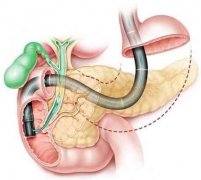 胆管结石患者1分钟与5分钟内镜乳头球囊扩张的长期疗效比较
背景和目的
胆管结石患者1分钟与5分钟内镜乳头球囊扩张的长期疗效比较
背景和目的:内镜乳头球囊扩张术(EPBD)是内镜下括约肌切开术治疗胆总管结石的一种替代方法。与内镜下括约肌切开术不同,EPBD保留了胆道括约肌功能,减少了50%胆总管结石的长期复发风险。指南建议EPBD持续时间超过2分钟,以充分放松括约肌,减少结石取出失败和ERCP术后胰腺炎的风险。然而,目前尚不清楚这种长时间的EPBD是否损害了括约肌功能,并否定了EPBD的长期效益。
方法:我们进行了一项随机对照试验,以确定长时间(>1分钟)EPBD与短时间EPBD(<1分钟)相比,是否增加了随后发生胆总管结石和肝胆并发症的风险。我们对2007年4月至2008年10月在台湾2个中心接受ERCP检查的170例成人胆总管结石患者进行了前瞻性研究。患者被随机分为两组,分别接受1分钟(n=86)或5分钟(n=84)的EPBD治疗,直至2015年6月。术后1个月行ERCP,并进行肝功能检查和腹部声像图检查。然后每3-6个月检查一次,平均随访时间约为7年。主要观察指标为胆总管结石复发或急性胆管炎,次要指标为肝胆并发症。我们用COX回归法评估EPBD持续时间的影响。
结果:EPBD1min组中13例(15.1%)后出现胆总管结石复发或急性胆管炎,EPBD 5 min组中10例(11.9%)在胆总管结石复发或急性胆管炎(P=.352)。肝胆并发症发生率组间无显着性差异(P=.154)。与1分钟EPBD相比,5分钟EPBD不增加主要预后风险(调整后危险度比0.76;95%置信区间0.32-1.82)或次要结果风险(调整危险比0.65;95%置信区间0.31-1.40)。机械碎石术是早期ERCP早期行EPBD取石失败的危险因素。在一项随机对照试验中,我们发现长时间EPBD(>1分钟)不会增加复发胆总管结石和肝胆并发症的风险,但机械碎石却增加了这些风险。
结论:随机对照研究发现,碎石可以增加胆总管结石复发率和肝胆并发症发生率,但是长时间(>1分钟)的EPBD却不会。
Comparable Long-term Outcomes of 1-Minute vs 5-Minute Endoscopic Papillary Balloon Dilation for Bile Duct Stones.
Kuo Y T, Wang H P, Chang C Y, et al. [J]. Gastrointestinal Endoscopy, 2016, 83(5):AB618-AB619.
Abstract
BACKGROUND & AIMS:Endoscopic papillary balloon dilation (EPBD) is an alternative to endoscopic sphincterotomy for choledocholithiasis. Unlike endoscopic sphincterotomy, EPBD preserves biliary sphincter function, reducing long-term risk of recurrent choledocholithiasis by 50%. Guidelines recommend that duration of EPBD exceeds 2 minutes, to adequately loosen the sphincter and reduce risks of failed stone extraction and post-endoscopic retrograde cholangiopancreatography (ERCP) pancreatitis. However, it is unclear whether this long duration of EPBD impairs sphincter function and negates the long-term benefit of EPBD.
METHODS: We performed a randomized controlled trial to determine whether long-duration (>1 minute) EPBD increases the risk of subsequent choledocholithiasis and hepatobiliary complications compared with short-duration EPBD (<1 minute). We performed a prospective study of 170 adult patients who underwent ERCP for suspected choledocholithiasis from April 2007 through October 2008 at 2 centers in Taiwan. Patients were randomly assigned to groups that underwent 1-minute (n = 86) or 5-minute (n = 84) EPBD for choledocholithiasis; patients were followed through June 2015. One month after the initial ERCP, patients were examined and liver function tests and abdominal sonographies were performed. Patients were then examined every 3-6 months over a median follow-up period of approximately 7 years. The primary outcome was recurrent choledocholithiasis or acute cholangitis and the secondary outcome was overall hepatobiliary complications. We assessed the effects of EPBD duration by Cox regression.
RESULTS:Thirteen patients (15.1%) developed recurrent choledocholithiasis or acute cholangitis after 1-minute EPBD, and 10 patients (11.9%) developed recurrent choledocholithiasis or acute cholangitis after 5-minute EPBD (P = .352). There was no significant difference between groups in number of hepatobiliary complications (P = .154). Compared with 1-minute EPBD, 5-minute EPBD did not increase risk of the primary outcome (adjusted hazard ratio, 0.76; 95% confidence interval, 0.32-1.82) or the secondary outcome (adjusted hazard ratio, 0.65; 95% confidence interval, 0.31-1.40). Mechanical lithotripsy, performed for failed stone extraction with EPBD at initial ERCP, was a risk factor for primary and secondary outcomes. In a randomized controlled trial, we found that the risk of recurrent choledocholithiasis and hepatobiliary complications did not increase with long-duration EPBD (>1 minute), but was increased with mechanical lithotripsy.
CONCLUSIONS: In a randomized controlled trial, we found that the risk of recurrent choledocholithiasis and hepatobiliary complications did not increase with long-duration EPBD (>1 minute), but was increased with mechanical lithotripsy.
翻译:胡越 审校:张立超、侯森林(Gastrointestinal Endoscopy, 2016)


